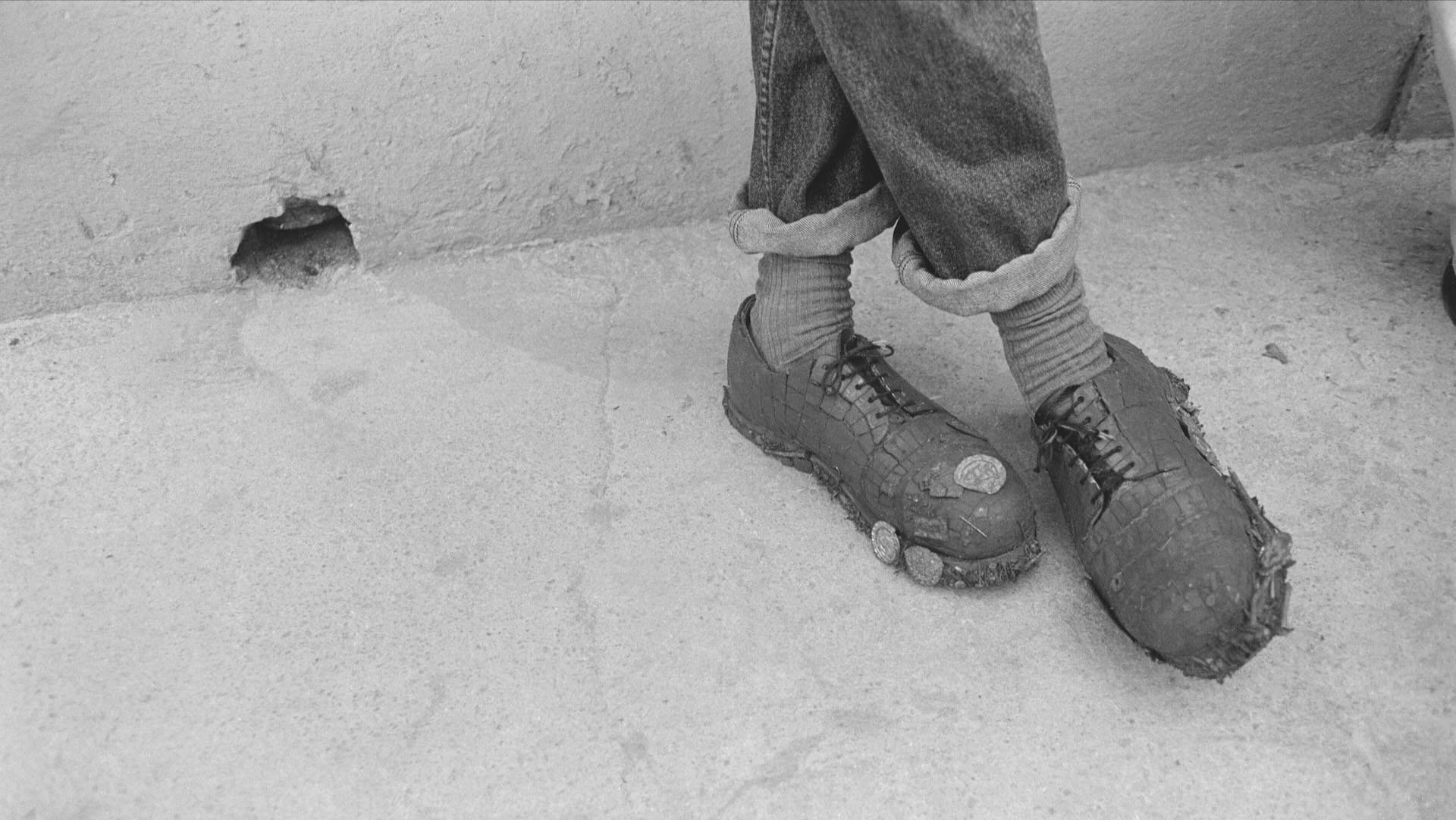Image: Francis Alÿs (BEL/MEX), Magnetic Shoes, 1994. Havana, Cuba. Video, 4 min 24 s.
CURATORIAL WORK: BIENALSUR, CLARISA APPENDINO (ARG)
VIDEO PROGRAMME: THE WALKING GAZE
THUR 12 OCT 9.00AM - FRI 20 OCT 5.00PM
DAILY LOOPED SCREENINGS IN THE PERFORMANCE SPACE (LEVEL 1, PLATFORM ARTS. EXCLUDES WEEKENDS)
FREE TO ATTEND
-
Monday 9.00am - 5.00pm
Tuesday 9.00am - 5.00pm
Wednesday 9.00am - 5.00pm
Thursday 9.00am - 5.00pm
Friday 9.00am - 5.00pm
Saturday closed
Sunday closed
-
Platform Arts is wheelchair-accessible via our Gheringhap St entrance. Unlocked, accessible bathrooms are available on both ground and first floors.
For accessibility enquiries, please directly contact us at hello@platformarts.org.au
Please note, Platform Arts is a dry venue.
The overproduction of goods - with its resulting generation of waste and garbage - along with the emphasis on high-speed mobility aiming to cover long distances in the shortest possible time, are two features of global contemporaneity. There is a type of artistic creation that underscores this condition of the present through a contrast: waste as a possibility and the act of walking as a symbol of slowness. As a result, artists from different corners of the world link the gleaning of waste objects to aimless walking, transforming their context into a space of search, sourcing materials for their works.
These artistic productions represent a type of work that consists in putting together objects that have lost their purpose, the construction of pieces with different objects and materials, or the classification and gathering of disparate things. Consequently, a special relationship between walking and collecting is established, in which collecting can be a momentary interruption of walking. This introduces another meaning of "objet trouvé"; that is to say, a found object or even an "object stumbled upon". The selection of videos produced by artists from different geographies connects these two actions: walking and collecting. Although some works place greater emphasis on one than the other, together they depict a particular way of moving, looking, searching, and trying to find things in their surroundings. The selected videos show how the artists work with objects found in their respective settings and their walk through space and time.
The works place the emphasis on walking without a predefined route or purpose. They highlight the nearby (mostly urban) world around the slow and purposeful walk. Others include the collection of garbage in different contexts: an abstract city, the banks of the Río de la Plata in Montevideo, Uruguay, and the streets of cities in Argentina. In these actions, the body absorbs everything that is directly or indirectly consumed. The objects gathered may be protuberances or prostheses, whether technological or natural. They also turn the body into a strange sort of sponge, both real and symbolic, which wanders through different contexts as it expands its capacity to absorb and collect and is at the same time a consumer and a producer of waste.
-
Carmela Gross (BRA)
13 Passers-by, 2015-2016
Video, 4 min 47 s
Carmela Gross's artistic production casts an insightful and critical look at the political and social dimensions of contemporary cities. In addition to the diversity of contexts and proposals she developed, the common thread is the relationship between the artwork and the city. Video animation 13 Passers-by features small figures made with black adhesive tape on a grid paper background. The figures move from one end of the screen to the other. The fragile balance of their lines highlights and singles out different ways of walking and crossing "the illuminated stage" of the projection.
Julia Levstein (ARG)
To Walk, 2021
Video, 16 min 8 s
Levstein's work uses drawing as a starting point to create texts, sculptures, videos, and installations. She thus engages in a dialogue between the conceptual and the sensitive to identify the point of tension between words and actions. The video To Walk is a simple, everyday action in which the body is a vehicle for displacement. In this silent action, the camera opts for a diagonal or zenithal angle of view instead of focusing on a general path through the conventional frontal view. Focused downwards, it captures the rhythm of the steps, the characteristics of the ground and the shadows that unfold with the movement of the feet.
Francis Alÿs (BEL/MEX)
Magnetic Shoes, 1994
Havana, Cuba. Video, 4 min 24 s
Francis Alys began his artistic career when he moved to Mexico City in the 1980s based on his reflection on the performativity of his works with a focus on the crossover between art, architecture, and social practices. Walking emerged then as a
space of aesthetic experimentation defined as a non-productive action and, according to Alys, as one of the last spaces of resistance: "Walking, in particular drifting, or strolling, is already - within the speed culture of our time - a kind of resistance. Paradoxically, it's also the last private space, safe from the phone or email." The video Magnetic Shoes is the recording of an ephemeral action presented in the 5th Havana Biennial in May 1994. Francis Alys put on his magnetic shoes and went for daily walks in the streets of Havana, picking up debris and scraps of metal he found along the way.
Valentina Cardellino (URY)
Scene in an Open Field, 2018
Full HD video, 2 min 8 s
This work is based on the study of an event: the objects that are carried by the river and accumulate in the bay of the Capurro quarter of Montevideo, Uruguay. Through a detailed linear drawing, the artist surveys each of the objects in an area of 25 m2. A camera at ground level records the movement of the water that drags, reveals, and conceals the objects it carries. The artist proposes these two pieces as evidence of a crime scene, that of an exceptional, unique, unsolved case.
Diego Bianchi (ARG)
Inflation 3, 2021
Single channel digital video, 12 min 52 s
In the Inflation series, the artist wonders whether the body is an ever-absorbing sponge. This image leads to the transformation of bodies as a way of revealing and rendering palpable everything that has been lived, eaten, enjoyed, and that ultimately defines us. In Inflation, bodies move with difficulty, but they also dance, interact and sleep. The video also presents a symphony of sounds generated and emitted by our bodies both voluntarily and involuntarily, such as breathing or the noises of the stomach. This project represents the bodily image of the present, where things and bodies are mutually devoured and at times the inside and the outside are indistinguishable.
-
From its Km 0 at MUNTREF (Museums of the Universidad Nacional de Tres de Febrero) Hotel de Inmigrantes venue in the City of Buenos Aires, to Tokyo, BIENALSUR maps out a new cartography for contemporary art that spans 18,370 kilometres, simultaneously connecting art spaces, creators, audiences and communities from all continents.
As of 2015, a series of Global South meetings were held that gave rise to a dynamic project rooted in dialogues, exchanges and presentations making up a diverse and sustained public programme. BIENALSUR was subsequently built on this foundation.
The first edition of BIENALSUR was held in 2017, featuring the participation of more than 400 artists across approximately 80 venues in 34 cities spanning 16 countries. In 2019, the map extended its reach, encompassing 112 venues in 47 cities in 21 countries. Despite the challenges posed by the pandemic in 2021, the biennial took place in 120 venues across 48 cities in 24 countries of the Americas, Asia and Euro. Over 1800 artists from all over the world participated throughout the first three editions.
Unprecedented in its methodology, BIENALSUR incorporates works and projects that arise from open, free, international calls without pre-established topics. This inclusive approach aims to encourage artists and curators to conceive specific proposals without the constraints of predetermined themes, and to pursue their own explorations.
From the Open Call emerge the itineraries as the primary curatorial axes of each edition. The selection criterion for the projects is the quality of each submission, both in conceptual and aesthetic terms.
With a steadfast determination to explore alternative dynamics for art and culture in the pursuit of new logics of artistic and social circulation both locally and globally, BIENALSUR 2023 continues to uphold the right to culture and diversity.
Over the course of six months, artists, curators, institutions, and communities from various corners of the world will join forces with growing simultaneity. amplifying their efforts to actively address contemporary challenges.








